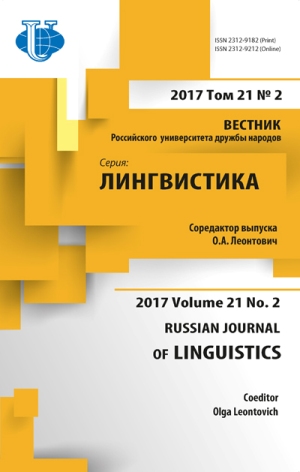卷 21, 编号 2 (2017)
- 年: 2017
- 文章: 16
- URL: https://journals.rudn.ru/linguistics/issue/view/953
- DOI: https://doi.org/10.22363/2312-9182-2017-21-2
完整期次
Articles
“A Mirror in which Everyone Displays their Image”: Identity Construction in Discourse
 247-259
247-259


Transnationalism as an Index to Construct European Identities: an Analysis of ‘Transeuropean’ Discourses
摘要
 260-281
260-281


Exploring the Intercultural Identity of Slovak-Roma Schoolchildren in the UK
摘要
 282-304
282-304


Discursive functions of Japanese Personal Pronouns
摘要
 305-319
305-319


Narratives about Displacement and Stigmatization of Identities
摘要
The displacement of people who leave their home to live in the streets is one of the social dramas commonly found in large urban areas. Despite forming a heterogeneous population group, these people are seen by society as one homogenous crowd, grouped together based on the generalizations of negative categorizations attributed to them. This article analyzes the displacement storytelling of a woman who lost her house to heavy rainstorms, which forced her to go live in the streets with her seven youngest children. Based on the concepts of membership categorization analysis, stigma and talking back, we aim to investigate how this former street dweller refutes the stigmatized identities that she knows are attributed to her, as well as how she claims an alternative identity. Her narrative was produced in the context of an interview for research on life stories. The results show that the storyteller seeks to build a coherent narrative for her own self by adopting a belief system to organize her life story and by providing explanations to the events in her life. Accordingly, she blames the street dwellers’ deviant behavior on the street environment, and also claims her status as a member of the “family” collection by invoking the dominant discourse on motherhood as an ideal of female fulfillment. Ultimately, this study highlights the importance of knowing the native categories, that is, the categories created by the members of the group whose actions are being studied, which challenge the categories conceived by outsiders.
 320-334
320-334


“A Significant Part of an Insignificant Identity”: the Re-Articulation of North-East Scots between Tradition and Globalization
摘要
In Britain the conflict between the national standard and regional languages and varieties, or rather those perceived to be ‘only’ a dialect, is still going strong and Scots plays a peculiar role in it. It is recognised and afforded a certain level of protection and promotion under the European Charter for Regional and Minority Languages (ECRML). While related to English, Scots has a number of regional varieties and it stands in competition with other varieties of English within Scotland. North-East Scots (NE Scots), also known as ‘the Doric’, in particular occupies a rather special place within the sphere of Scots. While research has often focused on the perceived status of urban versus rural Scots, this paper examines the attitudes towards NE Scots with regard to identity construction as displayed by its speakers in rural areas and small towns in the North-East. Another focal point is the use of the regional variety as a perceived act of resistance against the ostensible dominance of English. Within the mind of its speakers what kind of identity do they feel they have - a largely local/regional, a national Scottish, a British one or something entirely different? The analysis of interview data highlights that respondents’ statements and their actual linguistic behaviour reinforce the affirmation of their regional identity; the extent to which this occurs will also be investigated.
 335-347
335-347


Cultivation of Communicative Space: Polemical Eloquence vs. Epideictic Eloquence
摘要
 348-361
348-361


Text as an Element of Integrative Scientific Space
摘要
 362-378
362-378


Redefining Neutrality in Language and Discourse
摘要
 379-389
379-389


A Discourse-Based View in Interdisciplinary Approaches to Fictional Text Analysis
摘要
 390-404
390-404


“Promise” as Speech Behavior Pattern: Method of Contrastive Analysis (Based on Russian and German Languages)
摘要
 405-423
405-423


Logoepistems in Creolised Texts of Internet Discourse
摘要
 424-437
424-437


Review of Marklen E. Konurbaev (2016) The Style and Timbre of English Speech and Literature. Palgrave MacMillan
 438-440
438-440


International Conference on Language and Emotion, Madrid, Spain, 23-25 November, 2016
 441-445
441-445


The Fifth Liberal Arts International Conference: Reinventing Ourselves: Innovation and the Liberal Arts, Doha, Qatar, 29-31 January 2017
 446-450
446-450


O.A. Krylova (1937-2017)
 451-454
451-454














